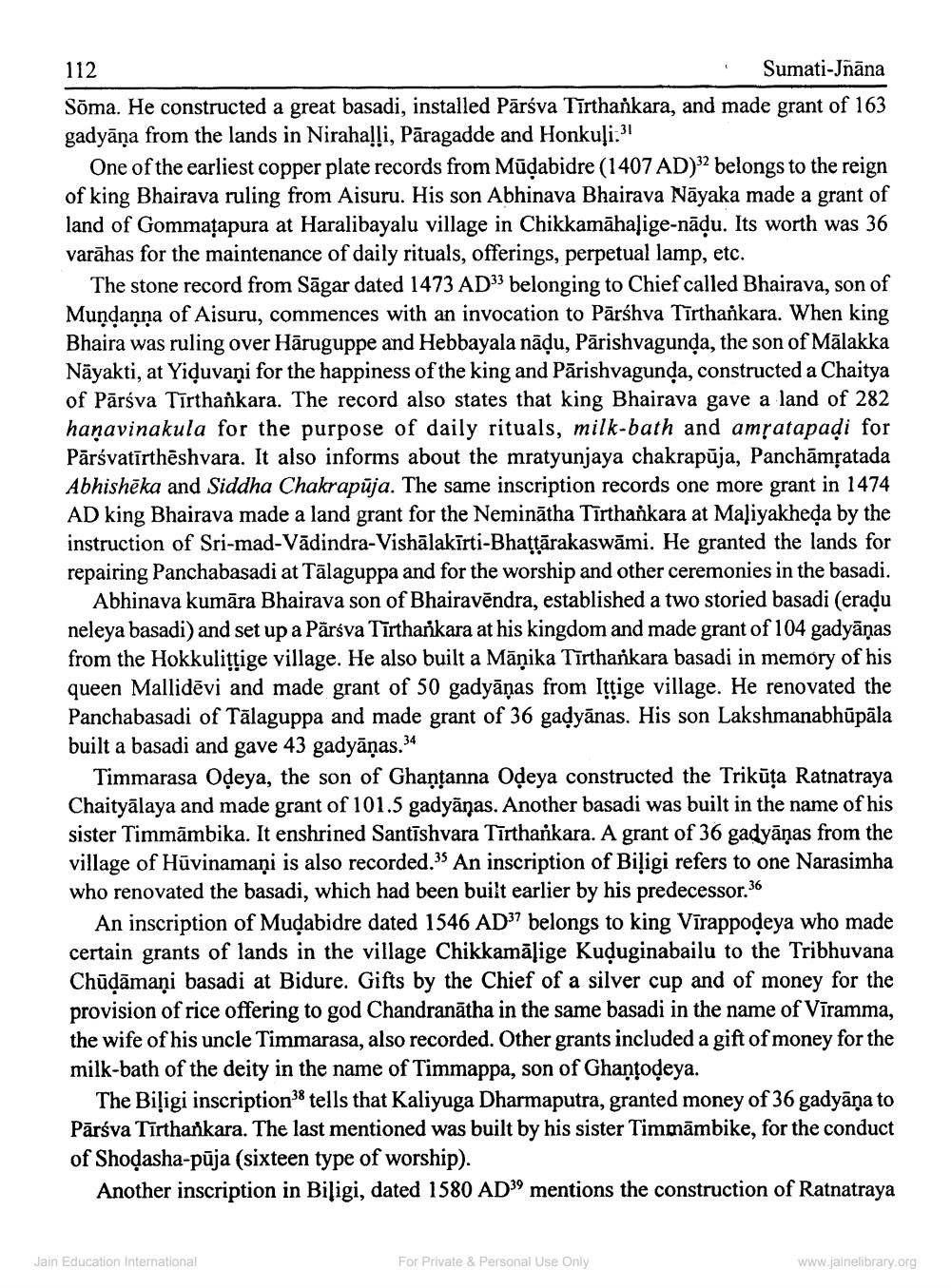________________
112
: Sumati-Jnāna Sõma. He constructed a great basadi, installed Pārsva Tīrthankara, and made grant of 163 gadyāna from the lands in Nirahalli, Pāragadde and Honkuļi:!
One of the earliest copper plate records from Mūdabidre (1407 AD) 32 belongs to the reign of king Bhairava ruling from Aisuru. His son Abhinava Bhairava Nāyaka made a grant of land of Gommatapura at Haralibayalu village in Chikkamāhalige-nādu. Its worth was 36 varāhas for the maintenance of daily rituals, offerings, perpetual lamp, etc.
The stone record from Sāgar dated 1473 AD33 belonging to Chief called Bhairava, son of Mundanna of Aisuru, commences with an invocation to Pārshva Tīrthankara. When king Bhaira was ruling over Hāruguppe and Hebbayala nādu, Pārishvagunda, the son of Mālakka Nāyakti, at Yiduvani for the happiness of the king and Pārishvagunda, constructed a Chaitya of Pārśva Tīrthankara. The record also states that king Bhairava gave a land of 282 hanavinakula for the purpose of daily rituals, milk-bath and amratapadi for Pārśvatīrthēshvara. It also informs about the mratyunjaya chakrapūja, Panchāmpatada Abhishēka and Siddha Chakrapūja. The same inscription records one more grant in 1474 AD king Bhairava made a land grant for the Neminātha Tīrthankara at Maliyakheda by the instruction of Sri-mad-Vādindra-Vishālakīrti-Bhattārakaswāmi. He granted the lands for repairing Panchabasadi at Tālaguppa and for the worship and other ceremonies in the basadi.
Abhinava kumāra Bhairava son of Bhairavēndra, established a two storied basadi (eraļu neleya basadi) and set up a Pārsva Tīrtharikara at his kingdom and made grant of 104 gadyānas from the Hokkulittige village. He also built a Mānika Tīrtharkara basadi in memory of his queen Mallidēvi and made grant of 50 gadyāṇas from Ittige village. He renovated the Panchabasadi of Tālaguppa and made grant of 36 gadyānas. His son Lakshmanabhūpāla built a basadi and gave 43 gadyānas.34
Timmarasa Odeya, the son of Ghantanna Odeya constructed the Trikūta Ratnatraya Chaityālaya and made grant of 101.5 gadyāṇas. Another basadi was built in the name of his sister Timmāmbika. It enshrined Santīshvara Tīrthankara. A grant of 36 gadyānas from the village of Hūvinamani is also recorded. An inscription of Biligi refers to one Narasimha who renovated the basadi, which had been built earlier by his predecessor.36
An inscription of Mudabidre dated 1546 AD37 belongs to king Vīrappodeya who made certain grants of lands in the village Chikkamāļige Kuduginabailu to the Tribhuvana Chūdāmani basadi at Bidure. Gifts by the Chief of a silver cup and of money for the provision of rice offering to god Chandranātha in the same basadi in the name of Vīramma, the wife of his uncle Timmarasa, also recorded. Other grants included a gift of money for the milk-bath of the deity in the name of Timmappa, son of Ghanțodeya.
The Biligi inscription tells that Kaliyuga Dharmaputra, granted money of 36 gadyāņa to Pārsva Tīrthankara. The last mentioned was built by his sister Timmāmbike, for the conduct of Shodasha-pūja (sixteen type of worship).
Another inscription in Biligi, dated 1580 AD39 mentions the construction of Ratnatraya
Jain Education International
For Private & Personal Use Only
www.jainelibrary.org




